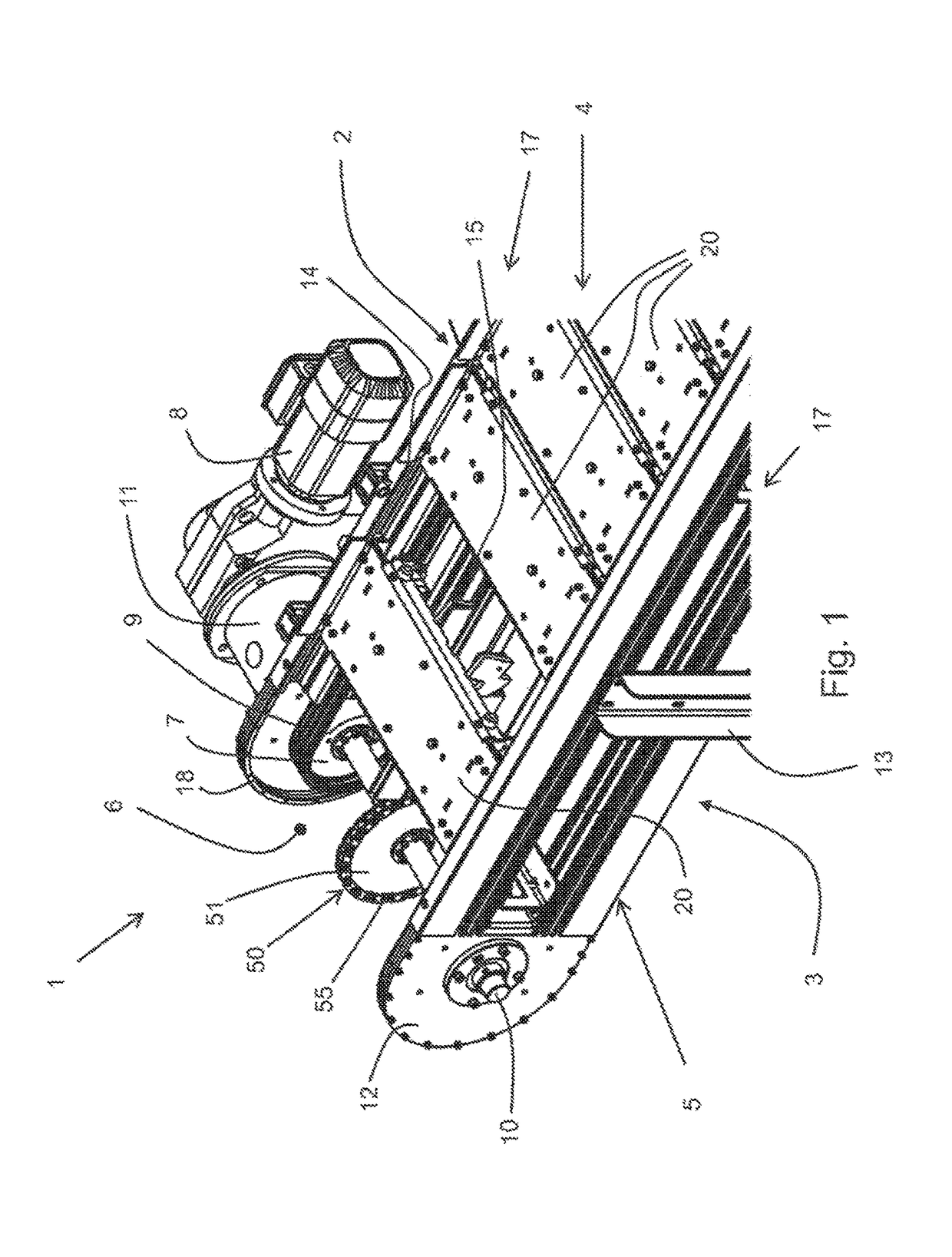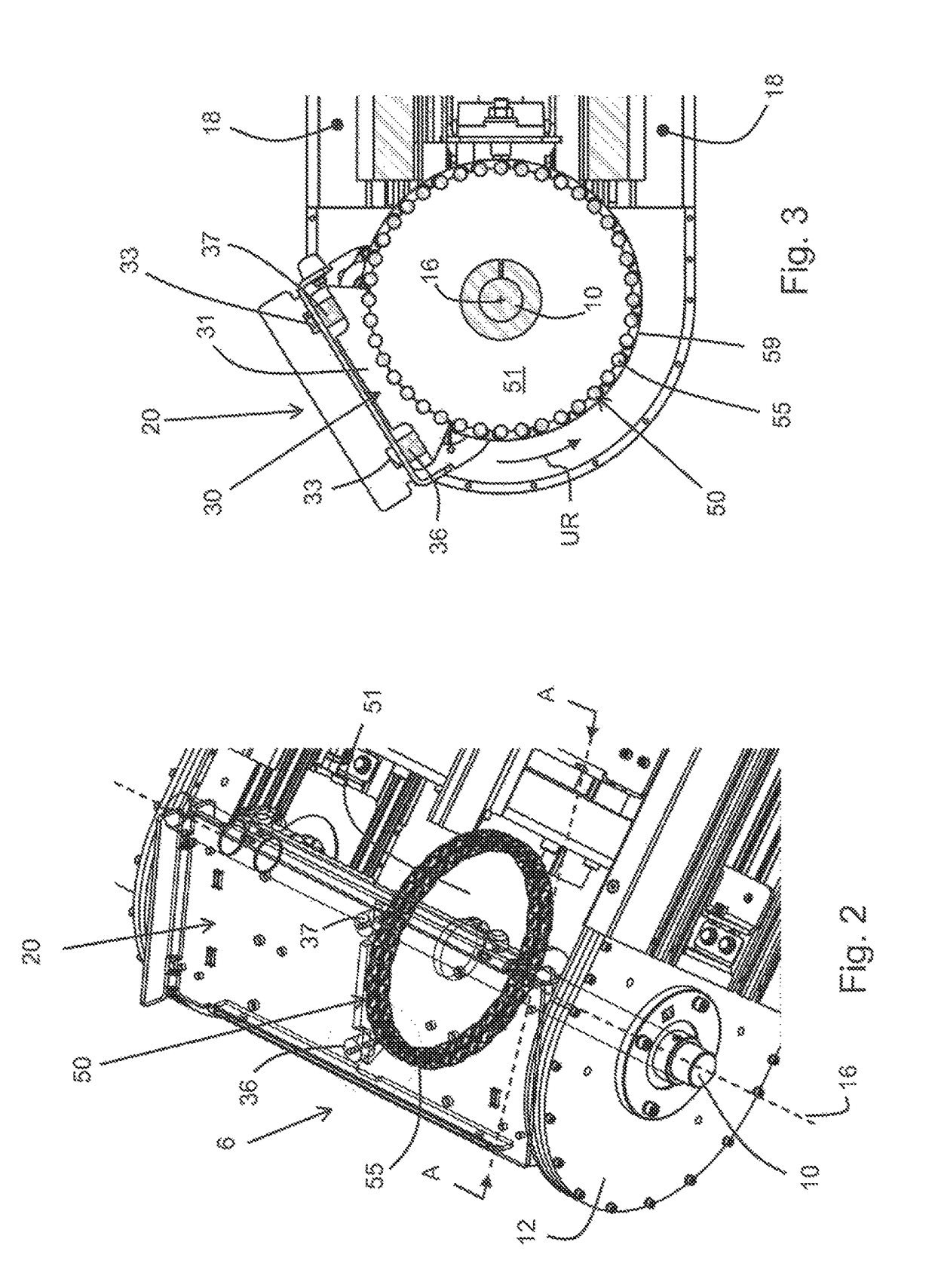Continuous conveyor
a conveyor and continuous technology, applied in the direction of conveyors, transportation and packaging, etc., can solve the problems of relatively complex structures and inability to lift pallets by operators, and achieve the effects of large angular coverage, cost-effectiveness, and simple implementation
- Summary
- Abstract
- Description
- Claims
- Application Information
AI Technical Summary
Benefits of technology
Problems solved by technology
Method used
Image
Examples
first embodiment
[0054]FIGS. 2-5 show a first form closure element or a frictional closure element 30. This is provided in the transverse center on the underside 22 of the pallet 20 and comprises a rigid component 31, which is formed to be elongated and extends in the circulating direction UR (see FIG. 3) of the pallet 20. The rigid component 31 features a toothed segment 40 with nine gear teeth 41, which form a concave envelope curve 39 (see FIG. 8) with a constant radius. Instead of nine gear teeth, toothed segments 40 with a different number of gear teeth 41, for example toothed segments 40 with three, six, eight or ten gear teeth 41, can also be used. In the present case, the nine gear teeth 41 extend across an angular range of approximately 70°. The connection to the underside 22 of the pallet 20 is effected by means of two cylindrical elastic buffer components 36, 37, whereas the buffer component 36 is arranged on the front side of the pallet 20 pointed towards the circulating direction UR, an...
third embodiment
[0063]FIGS. 9-11 show a first and second form closure element or frictional closure element 230, 250. With this embodiment, the first form closure element or frictional closure element 230 does not have elastic buffer components; rather; it solely comprises a rigid component 231, which is fastened (for example, welded) to the underside 22 of the pallet 20. The rigid component 231 features a toothed segment 40 that extends in the circulating direction UR and is directed away from the underside 22 of the pallet 20, and here also features nine gear teeth 41, the teeth peaks of which define an envelope curve 39 (see FIG. 11). The angular range a swept by the toothed segment 40 likewise amounts to approximately 65°.
[0064]According to the third embodiment, the second form closure element or frictional closure element 250 in the present case is not a gear wheel made of a solid material; rather, it features an inner rigid body 252 in the form of a disk with a smooth edge or a toothed rim, p...
fourth embodiment
[0066]FIGS. 12-14 show a fourth embodiment in which, in contrast to the preceding embodiments, a frictional closure is established between the first and second form closure elements or frictional closure elements 330, 350. For this purpose, the first form closure element or frictional closure element 330 is formed to be comparable to the first form closure element or frictional closure element 130 (elastic buffer component 36, deflection around the axis of rotation 35), with the difference that, instead of a toothed segment 40 on the rigid component 331, a uniform concave frictional surface 343 is provided, which in turns takes the form of an envelope curve 39 in the side view. The angular range a swept by the toothed segment 40 likewise amounts to approximately 65°. The second form closure element or frictional closure element 350 features a rigid body 352 with a convex frictional closure surface 353 that matches the concave frictional closure surface 343.
[0067]Upon the running agr...
PUM
 Login to View More
Login to View More Abstract
Description
Claims
Application Information
 Login to View More
Login to View More - R&D
- Intellectual Property
- Life Sciences
- Materials
- Tech Scout
- Unparalleled Data Quality
- Higher Quality Content
- 60% Fewer Hallucinations
Browse by: Latest US Patents, China's latest patents, Technical Efficacy Thesaurus, Application Domain, Technology Topic, Popular Technical Reports.
© 2025 PatSnap. All rights reserved.Legal|Privacy policy|Modern Slavery Act Transparency Statement|Sitemap|About US| Contact US: help@patsnap.com



